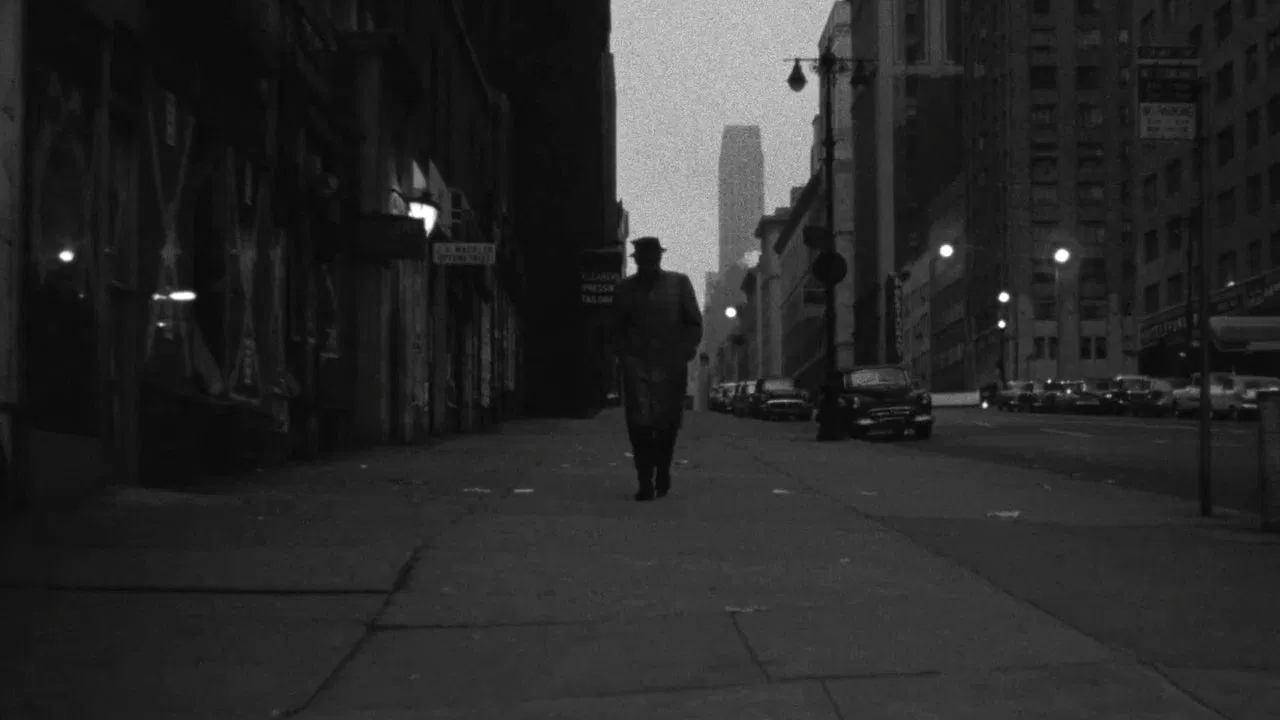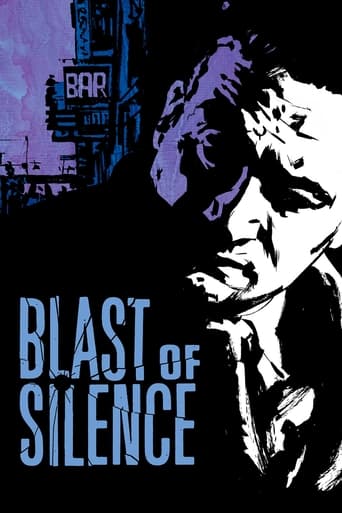

The most valuable asset to an ambitious young filmmaker of the 21st Century would probably be a time machine capable of returning you to the year 1960. Clocking in at just 77 minutes but seeming much longer, 'Blast of Silence' is further evidence that in those days it would have taken genius for an independent filmmaker NOT to create a classic city 'noir'. Just make sure there's film in your camera and take your pick from all the breathtaking compositions - complete with vintage cars and sharply dressed passers-by - constantly forming around you; even Michael Winner couldn't fail to turn in a black & white urban gem three years later with 'West 11' (1963).It certainly anticipates Jean-Pierre Melville's 'Le Samourai' (1967) - but then so do Kubrick's 'Killer's Kiss' (1955) and Robert Wise's 'Odds Against Tomorrow' (1959) - and plenty have been seduced by 'Blast of Silence's aura of monochrome period cool into extravagantly overpraising it. Allen Baron's inexpressive performance as hit-man Frankie Bono (he resembles a young George C. Scott) certainly provides a perfect blank slate on which to inscribe any profundities or angst that grab you. In his capacity as writer-director Baron at some point late in production evidently felt the need to do just that, calling upon two eminent blacklistees whose services at the time would have been available at an affordable price. The insistent narration reminiscent of Mark Hellinger's in 'The Naked City' was written under the pseudonym Mel Davenport by Waldo Salt (who later won Academy Awards for 'Midnight Cowboy' and 'Coming Home'), while the rasping voice of Lionel Stander is uncredited but unmistakable on the soundtrack, providing the glue which with Merrill Brody's photography holds the film together. Unfortunately much of what Stander keeps telling us on the soundtrack doesn't really need to be spelled out so relentlessly; while Meyer Kupferman's jazz score is extremely effective in moderation, but gets very noisy in places.SPOILERS COMING: Despite supposedly being such a pro, Frankie Bono's murder of Big Ralph (played by Larry Tucker, who I recognised from Sam Fuller's 'Shock Corridor') is remarkably amateurishly executed, his long-anticipated hit of Troiano no big deal, and he proves remarkably easy to ambush at the film's conclusion.
... View MoreThis film bridges the gap between classic 50s noir, and the more complex, improvisational dark NYC films to come, first by Cassavettes, and then by Scorsese. Very reminiscent of, if not as psychologically complex, surreal, and twisted as, the writings of Jim Thompson. A hit man from Cleveland comes to New York for one last job. The film uses 2nd person narration – 'You feel this', or 'You sense danger'. It's an interesting technique I can't remember encountering in a movie before, which plays with your head in a good way. Who's narrating the film? Obviously the 'you' is the main character, but by subtle implication it makes US him. The narration was written under a pseudonym by the great blacklisted writer Waldo Salt. Beautiful, stark and depressing photography – which I guess describes the film as a whole as well.A couple of terrific, odd supporting characters add to the nightmare atmosphere. While some of the acting is variable, and a few twists are too telegraphed, this is a film that has stuck with me.
... View MoreA hit man comes to New York for an assignment. This was the film debut for director, writer, and star Baron, who looks like a cross between Robert De Niro and George C. Scott. Some inexplicably compared this debut to Orson Welles and "Citizen Kane." Baron proves a failure in all three roles. The script is dull, the acting is amateurish, the direction is incompetent, and the cinematography is drab. There are too many shots of Baron walking from one place to another. What silence? The film starts with Lionel Stander, in his signature gravelly voice, providing the narration, and he hardly ever stops blabbering. He is so annoying that one wishes the hit man would take him out.
... View MoreI recall finding exactly one book on film in the big university bookstore in 1960, a collection of reviews from Newsweek's movie critic. My point is for younger folks who may not know that movies were not considered an art form until the late '60's. Before then, film was deemed a popular entertainment not worthy of serious study. Since Hollywood monopolized the industry and measured success in terms of box office, reducing the medium to little more than a commercial enterprise was not entirely misplaced. This is the landscape in which a nervy little indie like Blast of Silence tried to find some footing. Much of the early over-praise, I think, came from a growing number of folks who wanted film-making to declare greater independence from the Hollywood behemoth- certainly a praiseworthy desire. And, no doubt, the look and feel of the movie is unlike anything Hollywood turned out at the time. Fifty years later, what impresses me most is how competently the film is made, even considering the shoestring budget. The technical aspects, especially the cinematography, are as good as those found in contemporary studio products. The cross-cutting and editing of the night club sequence also show that Baron and crew could handle complex scenes as well as the many long master shots.At the same time, I'm curious as to where the film was shown since Universal did release it. The commercial appeal would, it seems, be limited by several important factors--- short length, over-narration, and unrelenting emphasis on alienation. There are no sympathetic characters; even the promising Lori (McCarthy) proves unreliably devious. Then too, the comparison with controversial Italian director Antonioni is not inapt considering the generally despairing mood and theme. Baron's one-man- effort thus appears neither art film nor commercial product, but something in-between, and where such a hybrid would be shown in those days is intriguingly unclear to me.Despite the rather esoteric character, I think the film has a continuing appeal, maybe not so much as entertainment, but as an object of aesthetic interest. Sure, the plot plus the character of Frank Bono owe a lot to Irving Lerner's similarly themed Murder by Contract of two years before. But the results here carry the whole notion of the outsider to an unusual degree. Even the claustrophobic streets amid towering skyscrapers project a crushing impersonality. At the same time, Bono kills, not only to succeed as a professional killer, but also, -if the narration is to be believed-, to relieve the victim (beneficiary) of the hopeless burden of life. Thus Bono eases into his own death when it comes. At a time when Ike was in the White House and Ozzie and Harriet were on TV, a darker counterpoint is hardly imaginable. As Vietnam would unfortunately demonstrate, it was indeed a film ahead of its time.
... View More